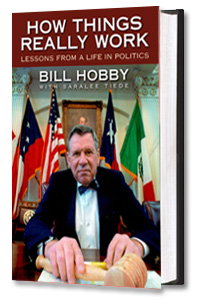President Clinton’s end-of-term pardons have come in for a lot of criticism. Executive clemency, as Presidential or Gubernatorial pardons are called, has played its part in Texas history, too.
Governor Sam Houston pardoned murderess Mary Monroe because the Texas Supreme Court opinion upholding her conviction had been written by Oran Roberts, then heading the convention that would lead Texas into secession.
“I’ll pardon her”, Houston said. “No citizen should be deprived of liberty by such a fellow.” The pardon itself simply reads “It being shown to me by petitions and facts presented that there is reason for the exercise of executive clemency….”. Seems reasonable to me.
Houston well knew that there are injustices in the “justice” system that can lead to locking up people for no good reason. Look at the recent spate of convictions overturned by DNA evidence. Houston pardoned more people (including several imprisoned slaves) than any of his predecessors.
The ability of the sovereign to correct injustice is well founded in history and much needed in fact. It’s one small weight in the balance against a prosecutor (like Kenneth Starr) gone mad in a system that needs more such weights. President Clinton’s pardon of Susan McDougal, for example.
Congress can make nutty laws. Pardons can at least help correct legislative abuses and restore some sanity to the system. President Clinton’s pardon of the woman who was in the federal pen for having an eagle feather, for example.
In Texas, attention was focused on pardons during the administrations of Governors James E. (1915-17) and Miriam A. (1925-27, 1933-35) Ferguson. The Governors Ferguson pardoned hundreds of prisoners, many of whom were in prison because they had violated Prohibition laws. Prohibition of alcohol was the religious right’s War on Drugs of three generations ago. Prohibition laws filled the prisons and ruined lives then just as marijuana laws do now. The Fergusons rightly concluded that the State was better served by these men being home supporting their families.
The Fergusons, like President Clinton, were accused of selling pardons. There was no credible evidence that they did so.
Just as Sam Houston did, the Fergusons used the power to pardon to remedy racial injustice. When “Ma” Ferguson took office in 1925 she pardoned many black convicts. John Ed Patten was among those pardoned. Patten was a Fourth Ward businessman who had committed the crime, in 1918, of defending himself when attacked by a policeman who was doubtless doing a bit of racial profiling.
Patten was also Barbara Jordan’s grandfather. The shooting took place on San Felipe Street, just a few blocks from where I am writing this essay.
My father, Governor William P. Hobby, who succeeded Governor Jim Ferguson in l917, made frequent pardons. In 1917, he asked a committee to tour the prisons and look for deserving prisoners who had no friends or relatives to intercede for them. At Christmas he pardoned thirty-five “forgotten men”. At the end of his term as governor he pardoned a black man, a convicted murderer, who helped raise me. That man was a part of our family for half a century.
(Hobby, Lieutenant Governor of Texas (1973-91), teaches political science at Rice University. He can be reached at [email protected]. A fully sourced version of this essay may be found at http://www.swt.edu/hobby/.

